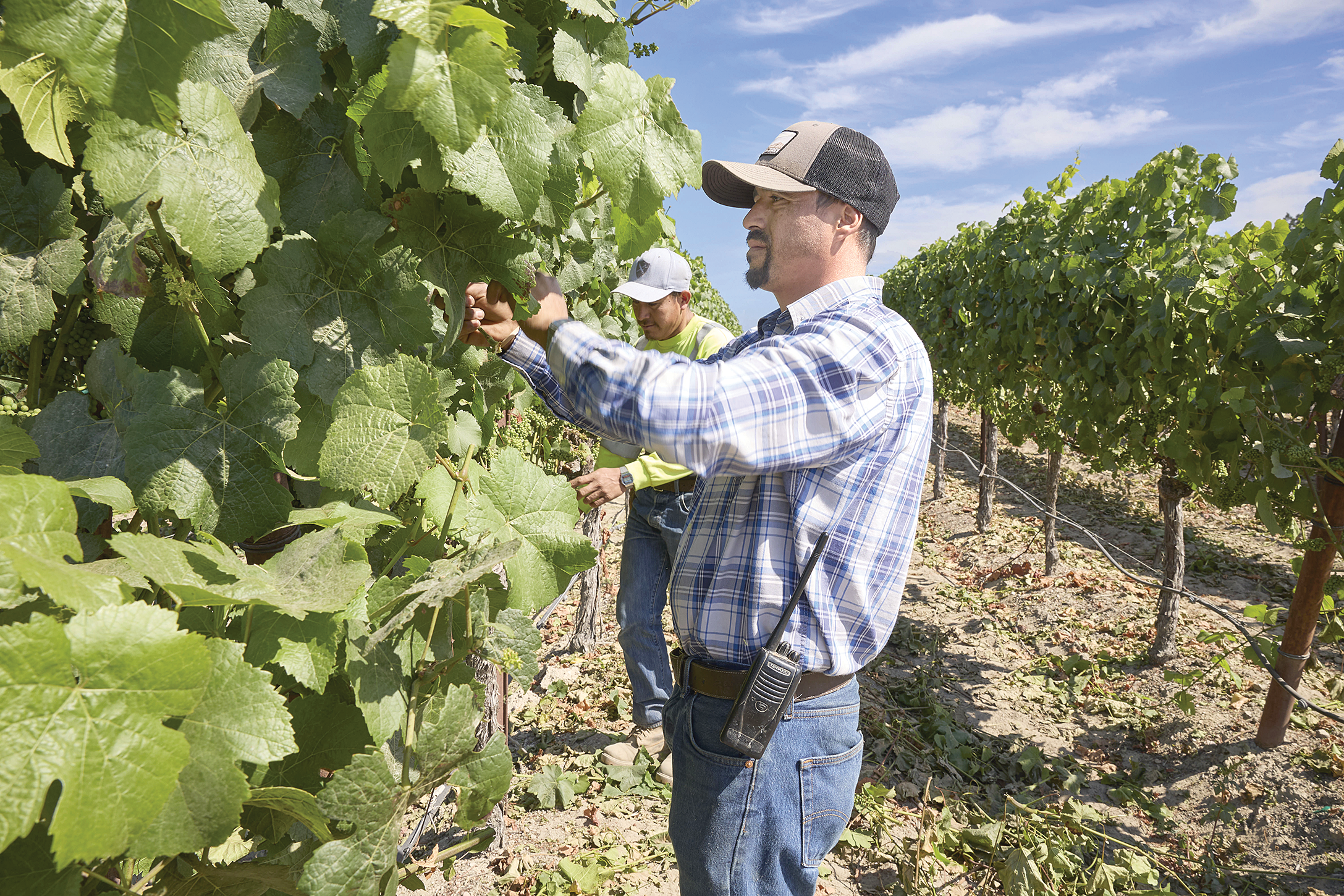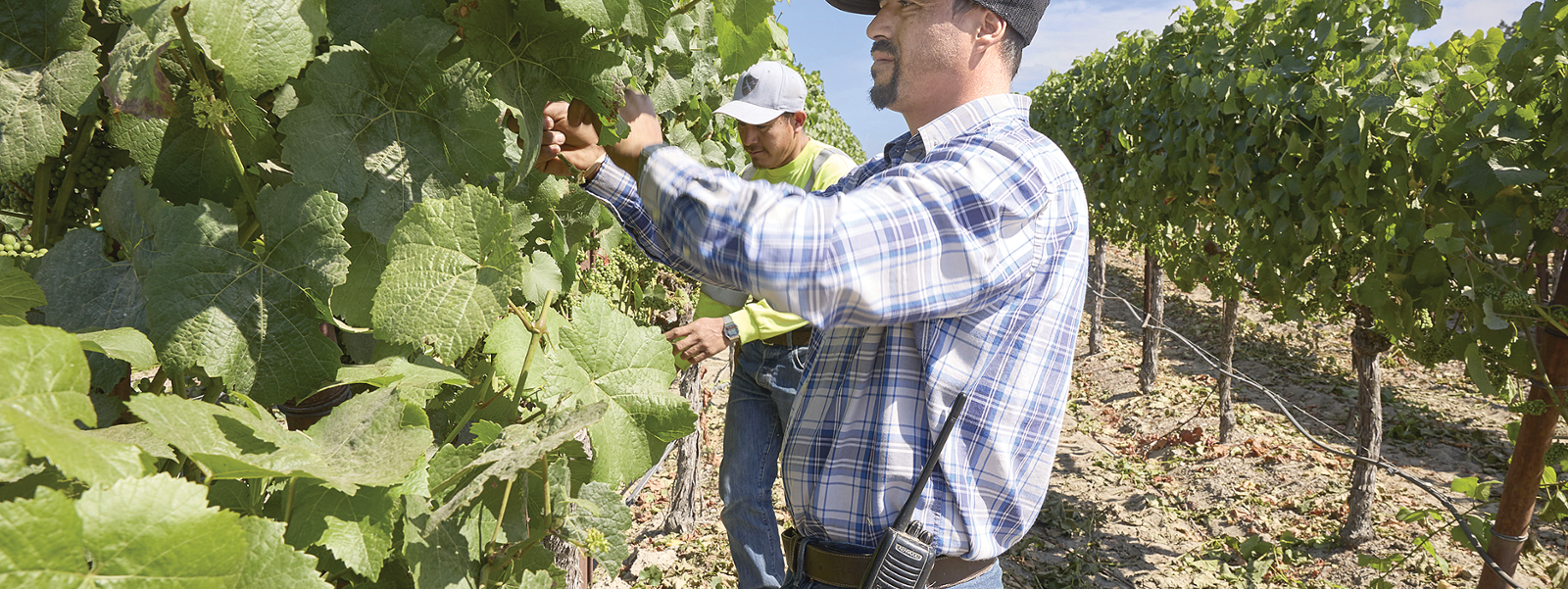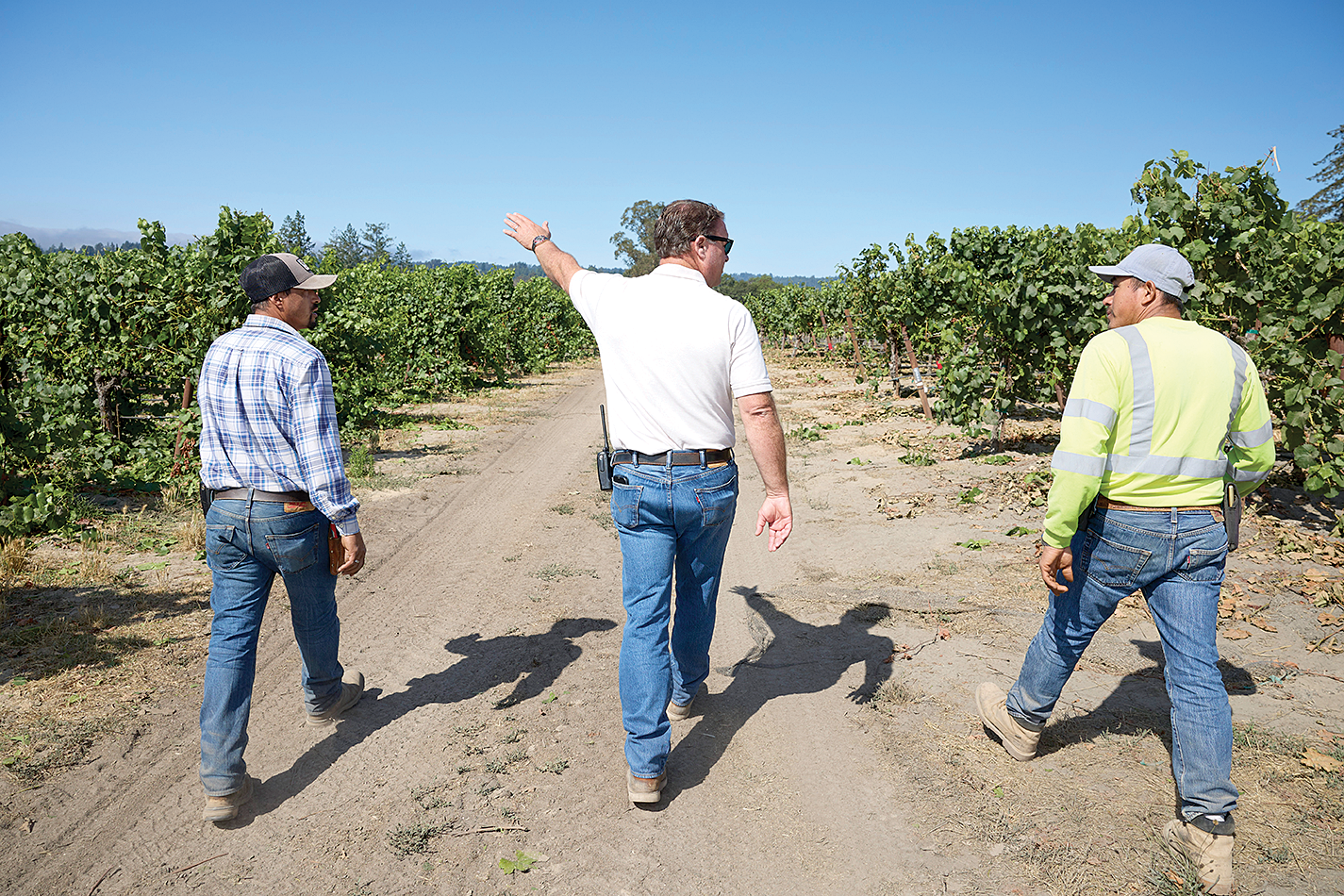Cooler season delays winegrape harvest

Luis Guillermo Velasquez, front, and José Martínez pull leaves last week at a Dutton Ranch vineyard in Sonoma County. This time last year, North Coast vineyards were already harvesting winegrapes, but the cool spring has delayed fruit development and harvest.
Photo/Fred Greaves


Photo/Fred Greaves
By Caleb Hampton
North Coast vineyards are preparing for a late winegrape harvest after a cold and overcast spring slowed fruit growth in the wine region.
“We’re pretty far behind,” said Johnnie White, operations manager of Piña Vineyard Management, which manages more than a thousand acres of winegrapes in Napa Valley.
Last week, crews moved along vines, pulling leaves to expose grape clusters to sunlight. But there’s only so much they can do to advance Mother Nature’s work.
“What they’re really working on is waiting for the grapes to get ripe,” said Jim Pratt, owner of Cornerstone Certified Vineyard in Sonoma County.
Local growers say this could be the coolest start to a Napa Valley winegrape season in many years, with fruit ripening delayed by at least three weeks.
Steve Dutton, owner of Dutton Ranch, which grows more than a thousand acres of winegrapes in Sonoma County, said this year’s crop and its timing seemed “more like a normal year from maybe 10 years ago before the drought started. This reminds me of one of those years.”
A year ago, the last of three consecutive drought years, vineyards in the region began harvest in late July. This year, despite being two weeks further into the season, Pratt’s chardonnay grapes had yet to turn from green to golden, and he and other North Coast growers said it could still be weeks before they start picking.
“I don’t think we’ll get busy until mid-September,” Pratt said.
Depending on weather, he added, harvest could extend into November, much later than last year’s harvest that saw vineyards rush to pick their white grapes before a week-long September heat wave left some of the remaining grapes sugary and dehydrated.
By the end of the season, the North Coast harvest was light. Statewide, it was the lightest grape crush in a decade.
“We’re due for a good harvest,” Pratt said of this year’s crop. He and other growers estimated an average yield, possibly a little better than average, though estimates varied.
“I think there’s less crop out there than people think,” White said. “I see some vineyards that look like they have a good crop on them and other vineyards that don’t have such a good crop.”
The Napa Valley vineyard manager added that “it depends a lot on when the vines went through bloom and what the weather was like.”
In Sonoma County, growers reported some losses occurring due to a poor fruit set along the coast. “I think the far west parts of Sonoma County are going to be light,” Pratt said.
A gloomy June caused some cluster “shatter,” when grape flowers fail to develop and set fruit during bloom.
“We have some ranches out to the west that have some shatter,” Dutton said, adding a small portion of his fruit was affected.
There may also be challenges ahead. With a late harvest, growers must manage their grapes through fall months that could bring damaging rains and wildfires.
“It should be interesting, because they’re saying it’s going to be an El Niño year with an early fall,” White said.
Growers have taken note of that long-range weather forecast, which is characterized by warm ocean currents and an increased likelihood of precipitation.
They said they are hoping rains hold off until late November, after they have been able to harvest varieties such as the region’s famous cabernet sauvignon winegrapes that are last to ripen.
An untimely rain could cause the fruit to take on too much water, diluting its flavor and impacting wine quality. Too much moisture can also cause mold or mildew to grow on the grape clusters and result in yield losses.
“I think a lot of people are trying to manage their vineyards right now so that they don’t have too big of a crop out there to make sure they have something they’re going to be able to get picked in time before the rain,” White said.
Crucial to that task is an adequate workforce, a major priority for vineyards that continue to navigate a nationwide farm labor shortage.
This year, North Coast winegrape growers reported having enough workers thanks in part to a multiyear investment in the H-2A guestworker program, which is permitted only when insufficient domestic workers can be found.
Dutton Ranch has used the program for the past 15 years, Dutton said, with about 90% of its individual H-2A workers returning from one year to the next.
The program “has helped tremendously,” said White, whose vineyard management company has also relied on it. “Before, everyone was fighting over the same small group of guys. Now, there’s still a small group of workers, but because there are so many H-2A workers here in Napa, the pressure is much less.”
Pratt, whose operation he said is too small to use the work visa program, said the number of guestworkers in North Coast vineyards has made it easier for him to find local workers to hire.
Growers are also using technology to fill the void. “We’re constantly looking to automate wherever we can,” Dutton said. “We’ve automated more of our mechanical leafing. We’ve done more of that this year than we ever have.”
Barring extreme weather events or early rains, growers were optimistic about the delayed crop. “Usually, a later crop means more hang time,” Dutton said, “and that should lead to good quality.”
Despite flattening growth in the wine sector in recent years, growers in Napa and Sonoma counties said their grapes remain in high demand from local wineries. At Dutton Ranch, everything was contracted by March, with prices up over last year.
“It has the potential to be a very high-quality year,” Dutton said. “We’re happy.”
(Caleb Hampton is an assistant editor of Ag Alert. He may be contacted at champton@cfbf.com.)




